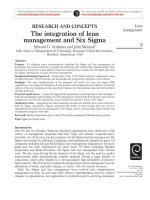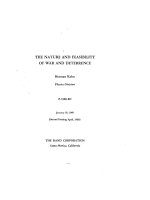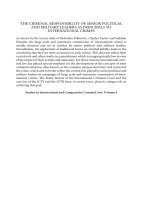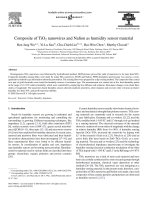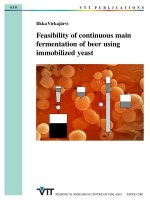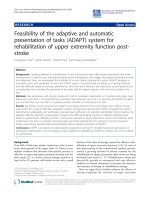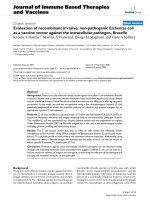Feasibility of probiotic lactobacillus and yeast as oral vaccine carrier against coronaviruses
Bạn đang xem bản rút gọn của tài liệu. Xem và tải ngay bản đầy đủ của tài liệu tại đây (2.64 MB, 381 trang )
FEASIBILITY OF PROBIOTIC LACTOBACILLUS AND
YEAST AS ORAL VACCINE CARRIER AGAINST
CORONAVIRUSES
HO PHUI SAN
DEPARTMENT OF MICROBIOLOGY
NATIONAL UNIVERSITY OF SINGAPORE
2005
FEASIBILITY OF PROBIOTIC LACTOBACILLUS AND
YEAST AS ORAL VACCINE CARRIER AGAINST
CORONAVIRUSES
HO PHUI SAN
(B. Sc. (Hons), NUS)
A THESIS SUBMITTED
FOR THE DEGREE OF PHILOSOPHY OF DOCTORATE
DEPARTMENT OF MICROBIOLOGY
NATIONAL UNIVERSITY OF SINGAPORE
2005
LIST OF PUBLICATIONS
I
LIST OF PUBLICATIONS
International peer review publications
1) Lee Y.K., Ho P.S., Low C.S., Arvilommi H. and Salminen S. (2004). Permanent
colonization by Lactobacillus casei is hindered by the low rate of cell division in
mouse gut. Appl Environ Microbiol. 70(2), 670-674.
2) Ho P.S., Kwang J. and Lee Y.K. (2005). Intragastric administration of
Lactobacillus casei expressing transmissible gastroentritis coronavirus spike
glycoprotein induced specific antibody production. Vaccine. 23(11), 1335-1342.
3) Lee Y.K., Hao W.L., Ho P.S., Nordling M.M., Low C.S., de Kok T.M. and Rafter
J. (2005). Human fecal water modifies adhesion of intestinal bacteria to Caco-2 cells.
Nutr Cancer. 52(1), 35-42.
4) Ho P.S. and Lee Y.K. Analysis of the ability of Saccharomyces boulardii,
Saccharomyces cerevisiae and Pichia pastoris to adhere to intestinal cell line and
murine gastrointestinal tract. (In preparation).
5) Ho P.S. and Lee Y.K. Development of a novel oral vaccine against severe acute
respiratory syndrome coronavirus using yeast as the delivery vehicle. (In preparation).
Conference publications
1) Ho P.S. and Lee Y.K. (2003). Daily consumption of Lactobacillus: Is it necessary?
7
th
NUS-NUH Annual Scientific Meeting, Singapore.
2) Ho P.S., Lee Y.K. and Kwang J. (2003). In vivo expression and immunogenicity of
coronavirus spike protein by Lactobacillus in murine model. 2nd Asian Conference
on Lactic Acid Bacteria (ACLAB), Taiwan. (Selected for Oral presentation).
3) Ho P.S., Lee Y.K. and Kwang J. (2003). Lactobacillus as oral vaccine carrier
against Coronavirus. The 6
th
Asia Pacific Congress on Medical Virology (ASCMV),
Malaysia. (Selected for Oral presentation).
4) Ho P.S., Lee Y.K. and Kwang J. (2004). Recombinant probiotic bacteria elicited
systemic and local immune responses against coronavirus. 5th Combined Annual
Scientific Meeting (CASM), Singapore.
LIST OF PUBLICATIONS
II
5) Ho P.S., Kwang J. and Lee Y.K. (2004). The Potential of Lactobacillus and yeast
as an oral vaccine delivery vector against coronaviruses. 8
th
NUS-NUH Annual
Scientific Meeting, Singapore. (Awarded Best Basic Science Poster Award).
6) Ho P.S., Kwang J. and Lee Y.K. (2005). Lactobacillus and yeast for vaccine
delivery against coronaviruses. Joint meeting of the 3 Divisions of the International
Union of Microbiological Societies (IUMS) 2005, Unites States of America.
(Selected for Oral presentation).
7) Ho P.S., Lee Y.K. (2005). Feasibility of developing Saccharomyces spp. and Pichia
spp. as vaccine delivery vehicle against coronavirus. Combined Scientific Meeting
(CSM) 2005, Singapore.
ACKNOWLEDGEMENT
III
ACKNOWLEDGEMENT
I would like to express my utmost gratitude and appreciation to the following people who
has made this project possible.
Associate Professor Lee Yuan Kun for his continued patience and unfailing support
throughout my course of study. It was a great pleasure for me to conduct this thesis
under his supervision. His selfless help and invaluable advice and guidance will always
be appreciated.
Professor Jimmy Kwang for his guidance and for giving me the opportunity to work in
his laboratory in Temasek Life Sciences Laboratory during the first year of my course.
Mr Liu Wei who was formally with Temasek Life Sciences Laboratory, for imparting his
invaluable knowledge and expertise on molecular techniques to me.
Mr Low Chin Seng for all his technical help and advices, as well as for the laughters we
have shared in the laboratory.
Josephine Howe and the staff from Electron Microscopy Unit for their technical
assistance.
The staff from flow-cytometry laboratory from Clinical Research Center, especially
Genie, who has already left, for their assistance.
Mdm Chew Lai Meng for all the encouragements and the motherly advices.
The postgraduates in our laboratory, Chow Wai Ling, Won Choong Yun, Lee Hui Cheng,
Wang Shugui and not forgetting Janice Yong Jing Ying, who has already graduated, for
their precious help and friendship along the way. Research life is definitely more
meaningful with your companionships.
The present and past honours students for their friendship and joy they have brought
during the stay.
My buddies outside NUS for their understanding, support and concern throughout this
period.
My family especially my husband for their patience and encouragement throughout these
years. Many things have happened and your love and support have helped me to pull
through this physically and emotionally draining period.
TABLE OF CONTENTS
IV
TABLE OF CONTENTS
PAGE NO.
CHAPTER 1 1
1.0 LITERATURE REVIEW 1
1.1 PROBIOTICS 1
1.1.1 Beneficial effects 2
1.1.2 Detrimental Effects of Probiotics 4
1.1.3 Methods to Analyze Adhesion of Intestinal Microorganism 5
1.2 LACTOBACILLUS 6
1.3 SACCHAROMYCES CEREVISIAE 8
1.3.1 Protein Expression in Saccharomyces Cerevisiae 9
1.4 SACCHAROMYCES BOULARDII 10
1.5 PICHIA PASTORIS 11
1.6 ADHESION 13
1.7 VACCINE 15
1.7.1 Types of Vaccines 15
1.7.1.1 Inactivated Vaccine 16
1.7.1.2 Live Attenuated Vaccine 16
1.7.1.3 Toxoid 18
1.7.1.4 Conjugated Vaccine 19
1.7.1.5 Subunit Vaccine 20
1.7.1.6 DNA Vaccine 21
1.7.2 Vaccine Delivery 22
1.7.2.1 Recombinant Vector Vaccines 22
1.7.2.1.1 Viral Vectors 23
1.7.2.1.2 Virus-like particles 24
1.7.2.1.3 Bacterial Vector 25
1.7.2.2 Transgenic Plant 26
1.7.2.3 Microencapsulation 27
TABLE OF CONTENTS
V
1.7.2.3.1 Liposome 27
1.7.2.3.2 Virosomes 28
1.7.2.3.3 Microspheres 29
1.7.3 Route of Vaccination 29
1.7.4 Immunity 30
1.7.4.1 Mucosal Immunity 32
1.7.4.1.1 Secretory IgA 34
1.7.4.2 Cytokines 35
1.7.4.2.1 Control of Virus Infections 37
1.8 CORONAVIRUSES 38
1.8.1 SEVERE ACUTE RESPIRATORY 41
SYNDROME CORONAVIRUS
1.8.1.1 SARS-CoV Spike Protein 43
1.8.1.2 Immunogenicity 44
1.8.2 TRANSMISSIBLE GASTROENTERITIS CORONAVIRUS 45
1.8.2.1 TGEV Spike Protein 47
1.8.2.2 Vaccines Developed Against TGEV 48
1.9 OBJECTIVES 49
CHAPTER 2
51
2.0 MATERIALS AND METHODS 51
2.1 ADHESION STUDIES 51
2.1.1 Bacteria and Yeast Strains 51
2.1.2 Adhesion Studies in Vivo 51
2.1.2.1 Preparation of Fluorogenic dye 51
2.1.2.2 Labeling of Lactobacillus spp. and Yeast With 52
Fluorescent Probe
2.1.2.3 Feeding of Mice With Labeled LcS or Yeast 53
2.1.2.4 Flow cytometric analysis 54
2.1.2.5 Mucus extraction from fecal material 54
TABLE OF CONTENTS
VI
2.1.3 Adhesion Studies In Vitro 55
2.2 MOLECULAR CLONING TECHNIQUES 55
2.2.1 Bacterial and Yeast Strains 55
2.2.2 Cloning and Expression Vectors 57
2.2.3 Restriction Digestion of DNA 59
2.2.4 Ligation and Transformation 59
2.2.5 Agarose Gel Electrophoresis 60
2.2.6 DNA Purification from Agarose Gel 61
2.2.7 Plasmid Isolation and Purification 61
2.3 GENERATION OF RECOMBINANT LCS EXPRESSING 62
TGEV SPIKE PROTEIN FRAGMENT
2.3.1 Complementary DNA (cDNA) Synthesis of TGEV gene 62
2.3.2 Amplification of TGEV Spike Gene 62
2.3.2.1 Primers Sequences and Related Information 62
2.3.2.2 Polymerase Chain Reaction (PCR) 63
2.3.3 Construction of Recombinant pLP500 Harboring TGEV 66
Spike Gene Fragment
2.3.3.1 Subcloning of rTGEV-S into pCR
®
-XL-TOPO
®
Vector 67
2.3.3.2 Cloning of rTGEV-S into pLP500 67
2.3.4 Preparation of Competent E.coli Cells for Chemical 67
Transformation
2.3.5 Generation of Recombinant L.casei Shirota Expressing rTGEV-S 68
2.3.5.1 Transformation of pLP500/rTGEV-S into E.coli 68
2.3.5.2 Confirmation of Transformants 68
2.3.5.3 Preparation of Competent Cells for Electroporation 69
2.3.5.4 Electroporation 70
2.3.5.5 Analysis of the Transformants 70
2.3.6 Expression of rTGEV-S Protein 71
TABLE OF CONTENTS
VII
2.4 GENERATION OF RECOMBINANT P.PASTORIS 72
EXPRESSING TGEV SPIKE PROTEIN FRAGMENT
2.4.1 Amplification of TGEV Spike Gene 72
2.4.1.1 Primers Sequences and Related Information 72
2.4.1.2 Polymerase Chain Reaction (PCR) 72
2.4.2 Cloning of TGEV Spike Gene Fragment into pGAPZαC 72
2.4.3 Transformation of pGAPZαC/PrTGEV-S into E.coli 73
2.4.4 Confirmation of Transformants 73
2.4.5 Generation of Recombinant P.pastoris Expressing rTGEV-S 74
2.4.5.1 Linearization of Recombinant Vector 74
2.4.5.2 Transformation of pGAPZαC/PrTGEV-S into P.pastoris) 75
2.4.5.2.1 Preparation of Competent P.pastoris 75
2.4.5.2.2 Transformation of competent P.pastoris 75
2.4.5.3 Analysis of the Transformants 76
2.4.5.3.1 Total DNA isolation form P.pastoris 76
2.4.5.3.2 PCR of Total DNA 76
2.4.6 Expression of PrTGEV-S Protein 77
2.5 GENERATION OF RECOMBINANT P.PASTORIS EXPRESSING 77
SARS CoV SPIKE PROTEIN FRAGMENT
2.5.1 Amplification of SARS CoV Spike Gene 77
2.5.1.1 Primers Sequences and Related Information 78
2.5.1.2 Polymerase Chain Reaction (PCR) 78
2.6 SODIUM-DODECYL SULFATE POLYACRYLAMIDE GEL 79
ELECTROPHORESIS (SDS-PAGE)
2.7 IMMUNOBLOTTING 80
2.7.1 Antibodies Used For Immunoblotting 81
2.8 IMMUNIZATION OF MICE 81
2.8.1 Collection of Intestinal Secretions 82
2.9 LARGE SCALE EXPRESSION OF TGEV SPIKE PROTEIN 83
2.9.1 Polymerase Chain Reaction (PCR) 83
2.9.2 Cloning of TGEV Spike Gene Fragment into pGEX-4T-3 84
TABLE OF CONTENTS
VIII
2.9.3 Induction of TGEV-S-GST 84
2.9.4 Purification of TGEV-S-GST 85
2.10 ELISA 85
2.11 CYTOKINE PROFILING 86
2.11.1 Preparation of Peyer’s Patches and Cervical Lymph Node for 86
In Vitro Re-stimulation
2.11.2 Cytokine Assay 87
2.12 CELL CULTURE TECHNIQUES 88
2.12.1 Cell Lines 88
2.12.2 Media for Cell Culture 89
2.12.3 Cultivation and Propagation of the Cell Lines 89
2.12.4 Cultivation of Cells in 6-Well, 24-Well and 96-Well Tissue 90
Culture Tray
2.12.5 Cultivation of Cells on Glass Coverslips 90
2.12.5.1 Pretreatment of Coverslips 90
2.12.5.2 Culture of Cells on Coverslips 90
2.12.6 Storage of Cells 91
2.13 INFECTION OF CELLS 92
2.13.1 Viruses 92
2.13.2 Infection of Cell Monolayers 92
2.13.4 Neutralization Assay 93
2.13.4.1 Plaque Neutralization Assay 93
2.13.4.2 Fluorescent Focus Assay 94
2.13.5 Extraction of Virus RNA Molecules 95
2.14 BIO-IMAGING VIA SCANNING ELECTRON MICROSCOPY (SEM) 95
TABLE OF CONTENTS
IX
CHAPTER 3 97
3.0 ADHESION STUDIES 97
3.1 INTRODUCTION 97
3.2 IN VITRO ADHESION STUDIES USING SCANNING 98
ELECTRON MICROSCOPY
3.3 IN VIVO ADHESION STUDIES 103
3.3.1 Murine Intestinal Surface Water and Mucus Content 103
3.3.2 Analysis of Lactobacillus casei Shirota Adhesion in Murine 103
Intestinal Tract
3.3.3 Analysis of Saccharomyces boulardii Adhesion in Murine 111
Intestinal Tract
3.3.4 Analysis of Saccharomyces cerevisiae Adhesion in Murine 118
Intestinal Tract
3.3.5 Analysis of Pichia pastoris Adhesion in Murine Intestinal Tract 125
CHAPTER 4
132
4.0 DEVELOPMENT OF ORAL VACCINE AGAINST 132
TRANSMISSIBLE GASRTOENTERITIS CORONAVIRUS
4.1 INTRODUCTION 132
4.2 GENERATION OF TGEV-S-GST 132
4.3 L.CASEI SHIROTA AS ORAL VACCINE CARRIER AGAINST 135
TGEV
4.3.1 Generation of Recombinant LcS Expressing rTGEV-S Protein 135
4.3.2 Immune responses induced by intragastric immunization of 141
LcS-rTGEV-S
4.3.3 Kinetics of cytokine production by Peyer’s patches from 149
mice orally immunized with LcS-rTGEV-S
4.4 P.PASTORIS AS ORAL VACCINE CARRIER AGAINST TGE 152
4.4.1 Generation of Recombinant P.pastoris (PP) Expressing 152
PrTGEV-S Protein
TABLE OF CONTENTS
X
4.4.2 Immune responses induced by intragastric immunization of 155
PP/PrTGEV-S
4.4.3 Kinetics of cytokine production by Peyer’s patches and cervical 162
lymph node from mice orally immunized with PP/PrTGEV-S
CHAPTER 5
165
5.0 DEVELOPMENT OF ORAL VACCINE AGAINST SEVERE ACUTE 165
RESPIRATORY SYNDROME CORONAVIRUS (SARS CoV)
5.1 INTRODUCTION 165
5.2 GENERATION OF RECOMBINANT P.PASTORIS EXPRESSING 165
SARS CoV SPIKE RECEPTOR-BINDING DOMAIN PROTEIN
5.3 IMMUNE RESPONSES INDUCED BY INTRAGASTRIC 171
IMMUNIZATION of PP/SARS-S-RBD
5.3.1 Kinetics of cytokine production by Peyer’s patches from mice 178
orally immunized with PP/SARS-S-RBD
CHAPTER 6
183
6.0 DISCUSSION 183
6.1 CONCLUSION 214
6.1.1 Adhesion Studies 214
6.1.2 Development of Oral Vaccine Against TGEV 215
6.1.3 Development of Oral Vaccine Against SARS CoV 216
REFERENCES 217
APPENDICES 287
APPENDIX 1 MATERIALS FOR BACTERIAL AND YEAST CULTURE 287
APPENDIX 2 MATERIALS FOR MOLECULAR CLONING 290
TABLE OF CONTENTS
XI
APPENDIX 3 MATERIALS FOR SODIUM DODECYL SULPHATE – 296
POLYACRYLAMIDE GEL ELECTROPHORESIS
(SDS-PAGE)
APPENDIX 4 MATERIALS FOR IMMUNOBLOTTING 299
APPENDIX 5 MATERIALS FOR CELL CULTURE 300
APPENDIX 6 MATERIALS FOR VIRUS INFECTION, GROWTH OF 304
VIRUS AND PLAQUE ASSAY
APPENDIX 7 MATERIALS FOR BIO-IMAGING 306
APPENDIX 8 DATA FOR CHAPTER 3 309
APPENDIX 9 DATA FOR CHAPTER 4 329
APPENDIX 10 DATA FOR CHAPTER 5 345
LIST OF TABES
XII
LIST OF TABLES
PAGE NO.
Table 1.1
Comparison of current vaccination strategies with DNA
vaccination technology.
17
Table 1.2
Nature of immunologic reactivity after systemic or
mucosal immunization with conventional live or
inactivated vaccines.
31
Table 1.3
Cytokines and biological activities.
35
Table 2.1
Bacterial and yeast strains used in adhesion study.
51
Table 2.2
Bacteria and yeast strains used in the study.
56
Table 2.3
Molecular vectors and related information.
57
Table 2.4
Primers used in this part of study. (Section 2.3.2.1)
63
Table 2.5
Primers used in this part of study. (Section 2.4.1.1)
72
Table 2.6
Primers used in this part of study. (Section 2.5.1.1)
78
Table 2.7
Primary and secondary antibodies used for
immunoblotting.
81
Table 2.8
Primers used in this part of study. (Section 2.9.1)
83
Table 2.9
Cell lines and related information. 92
Table 2.10
Viruses and related information. 92
Table 3.1
Fluorescence intensity profiles of lactobacilli harvested
from various sections of the intestinal mucosal surface on
various days after orogastric intubation of LcS.
109
Table 3.2
Fluorescence intensity profiles of S.boulardii harvested
from various sections of the intestinal mucosal surface on
various days post orogastric intubation.
116
LIST OF TABES
XIII
Table 3.3
Fluorescence intensity profiles of S.cerevisiae harvested
from various sections of the intestinal mucosal surface on
various days post orogastric intubation.
123
Table 3.4
Fluorescence intensity profiles of P.pastoris harvested
from various sections of the intestinal mucosal surface on
various days post orogastric intubation.
130
LIST OF FIGURES
XIV
LIST OF FIGURES
PAGE NO.
Figure 1.1
Current mucosal delivery systems, mucosal inductive sites
and the concept of Th1- and Th2-type immune responses.
32
Figure 1.2
Genome organization of SARS coronavirus.
39
Figure 1.3
Arrangement of the structural proteins and viral RNA
within an infectious virus particle of the coronavirus.
40
Figure 2.1
Porcine transmissible gastroenteritis virus spike protein S
mRNA sequences (GenBank accession number
AF302263) downloaded from NCBI website
(http//:www.ncbi.nlm.nih.gov).
66
Figure 2.2
Insertion of plasmid 5’ to the intact GAP promoter locus.
74
Figure 3.1
Observation by scanning electron microscopy of the
adherence of S.boulardii, S.cerevisiae and P.pastoris to
human intestinal epithelial Caco-2 cells.
100
Figure 3.2
Adhesion of S.boulardii, S.cerevisiae and P.pastoris to
human mucus-secreting HT29 cells observed by scanning
electron microscopy.
101
Figure 3.3
P.pastoris whole cells interacted with the mucus secreted
by the HT29 cells.
102
Figure 3.4
cFDA-SE labelling of LcS.
104
Figure 3.5
Plot of the residual median fluorescence intensity of LcS
adhering on the various sections of the intestinal tract
against the generation number.
105
Figure 3.6
Plot of total LcS cell number adhered on various sections
of the intestinal tract against time after orogastric
intubation.
106
Figure 3.7
Plot of the residual median fluorescence intensity of LcS
adhered on various sections of the intestinal tract against
time after orogastric intubation.
107
LIST OF FIGURES
XV
Figure 3.8
Plots showing the division profiles of total population of
adhering LcS.
110
Figure 3.9
cFDA-SE labelling of S.boulardii. 111
Figure 3.10
Plot of the residual median fluorescent intensity of
S.boulardii adhered on the various sections of the
intestinal tract against the generation number.
112
Figure 3.11
Plot of total S.boulardii cell number adhered on various
sections of the intestinal tract against time after orogastric
intubation.
113
Figure 3.12
Plot of residual median fluorescence intensity of
S.boulardii adhered on various sections of the intestinal
tract against time after orogastric intubation.
114
Figure 3.13
Plots showing the division profiles of total population of
adhering S.boulardii.
117
Figure 3.14
cFDA-SE labelling of S.cerevisiae.
118
Figure 3.15
Plot of the residual median fluorescent intensity of
S.cerevisiae adhered on the various sections of the
intestinal tract against the generation number.
119
Figure 3.16
Plot of total S.cerevisiae cell number adhered on various
sections of the intestinal tract against time after orogastric
intubation.
120
Figure 3.17
Plot of residual median fluorescence intensity of
S.cerevisiae adhered on various sections of the intestinal
tract against time after orogastric intubation.
121
Figure 3.18
Plots showing the division profiles of total population of
adhering S.cerevisiae.
124
Figure 3.19
cFDA-SE labelling of P.pastoris.
125
Figure 3.20
Plot of the residual median fluorescent intensity of
P.pastoris adhered on the various sections of the intestinal
tract against the generation number.
126
LIST OF FIGURES
XVI
Figure 3.21
Plot of total P.pastoris cell number adhered on various
sections of the intestinal tract against time after orogastric
intubation.
127
Figure 3.22
Plot residual median fluorescence intensity of P.pastoris
adhered on various sections of the intestinal tract against
time after orogastric intubation.
128
Figure 3.23
Plots showing the division profiles of total population of
adhering P.pastoris.
131
Figure 4.1
Agarose gel electrophoresis of PCR amplified TGEV
spike gene fragment to be ligated to the 3’ end of GST.
134
Figure 4.2
Restriction digested plasmids extracted from E.coli
transformants electrophorized on agarose gel.
134
Figure 4.3
Expression and purification of TGEV-S-GST protein by
recombinant E.coli after IPTG induction.
135
Figure 4.4
Agarose gel electrophoresis of PCR products of rTGEV-
S, amplified from cDNA synthesized from viral genomic
RNA.
136
Figure 4.5
Schematic diagram of the construction of recombinant
Lactobacillus spp. expression vector harboring rTGEV-S
gene fragment.
137
Figure 4.6
Electrophoretogram of BamHI and NheI digested pCR
®
-
XL-TOPO
®
vector in which rTGEV-S have been
subcloned.
138
Figure 4.7
Electrophoretogram of BamHI and NheI digested
plasmids isolated from E.coli DH10β transformants.
139
Figure 4.8
PCR of recombinant pLP500/rTGEV-S extracted from
LcS transformants.
140
Figure 4.9
Expression of rTGEV-S protein from LcS-rTGEV-S.
141
Figure 4.10
Schematic diagram showing the oral vaccination regime
of recombinant LcS to BALB/c mice.
142
Figure 4.11
Production of rTGEV-S protein specific intestinal IgA and
serum IgG in mice fed with LcS-rTGEV-S.
143
LIST OF FIGURES
XVII
Figure 4.12
rTGEV-S protein specific local IgA responses in murine
intestinal lavage after intragastric immunization.
144
Figure 4.13
Anti-rTGEV-S serum IgG titers induced after intragastric
immunization with recombinant LcS.
148
Figure 4.14
Inhibition of viral plaque formation by (A) intestine
lavages and (B) sera prepared from mice fed with
recombinant LcS.
148
Figure 4.15
IL-2, IFN-γ, IL-4 and IL-5 production by Peyer’s patches
cells from mice immunized orally with LcS-rTGEV-S or
LcS after re-stimulated with concanavalin A.
150
Figure 4.16
Kinetics of Th1 (IL-2 and IFN-γ) and Th2 (IL-4 and IL-5)
cytokines production by Peyer’s patches cells from mice
immunized with LcS-rTGEV-S and LcS.
151
Figure 4.17
Agarose gel electrophoresis of PCR amplified PrTGEV-S
(2.3 kb).
152
Figure 4.18
PCR screening of plasmids isolated from transformants.
(Section 4.4.1)
153
Figure 4.19
Electrophoretogram of PCR products amplified from
genomic DNA isolated from P.pastoris transformants.
(Section 4.4.1)
154
Figure 4.20
Expression of PrTGEV-S protein from P.pastoris
transformants.
155
Figure 4.21
Schematic diagram showing the oral vaccination regime
of PP/PrTGEV-S to BALB/c mice.
156
Figure 4.22
Immunogenicity of induced intestinal IgA and serum IgG
specific for PrTGEV-S protein.
157
Figure 4.23
PrTGEV-S protein specific local IgA response in murine
intestinal lavage after intragastric immunization.
158
Figure 4.24
Humoral immune responses after intragastric
immunization with recombinant P.pastoris (PP/PrTGEV-
S).
160
LIST OF FIGURES
XVIII
Figure 4.25
Inhibition of viral plaque formation by (A) intestine
lavages and (B) sera prepared from mice orally fed with
PP/PrTGEV-S and P.pastoris.
161
Figure 4.26
IL-2, IFN-γ, IL-4 and IL-5 production by Peyer’s patches
cells from mice immunized orally with PP/PrTGEV-S or
P.pastoris after re-stimulated with concanavalin A.
163
Figure 4.27
Kinetics of Th1 (IL-2 and IFN-γ) and Th2 (IL-4 and IL-5)
cytokine production by Peyer’s patches cells from mice
immunized with PP/PrTGEV-S and P.pastoris.
164
Figure 5.1
Agarose gel electrophoresis of PCR products of SARS-S-
RBD, amplified from pCR-XL-TOPO-S.
167
Figure 5.2
PCR screening of plasmids isolated from transformants.
(Section 5.2)
167
Figure 5.3
Electrophoretogram of PCR products amplified from
genomic DNA isolated from P.pastoris transformants.
(Section 5.2)
168
Figure 5.4
Agarose gel electrophoresis for the comparison of the
amount of total DNA extracted from four P.pastoris
transformants.
169
Figure 5.5
Expression of SARS-S-RBD protein from P.pastoris
transformants.
170
Figure 5.6
Schematic diagram showing the oral vaccination regime
of PP/SARS-S-RBD to BALB/c mice.
171
Figure 5.7
Immunogenicity of induced intestinal IgA and serum IgG
specific for SARS-S-RBD protein.
172
Figure 5.8
SARS-S-RBD protein specific local IgA response in
murine intestinal lavage after intragastric immunization.
173
Figure 5.9
Anti-SARS-S-RBD serum IgG titers induced after
intragastric immunization with PP/SARS-S-RBD.
176
Figure 5.10
Inhibition of MLV(SARS) infection by (A) intestine
lavages and (B) sera prepared from mice fed with
PP/SARS-S-RBD.
177
LIST OF FIGURES
XIX
Figure 5.11
IL-2, IFN-γ, IL-4 and IL-5 production by cells from
Peyer’s patches (A) and CLN (B) of mice immunized
orally with PP/SARS-S-RBD or P.pastoris after re-
stimulated with concanavalin A.
180
Figure 5.12
Kinetics of Th1 (IL-2 and IFN-γ) and Th2 (IL-4 and IL-5)
cytokine production by Peyer’s patches cells from mice
immunized with PP/SARS-S-RBD and P.pastoris.
181
Figure 5.13
Kinetics of Th1 (IL-2 and IFN-γ) and Th2 (IL-4 and IL-5)
cytokine production by CLN cells from mice immunized
with PP/SARS-S-RBD and P.pastoris.
182
LIST OF FIGURES
XX
ABBREVIATIONS
Ω
- ohm
%
- percentage
°C
- degree celsius
μF
- capacitance
μg
- microgram
μl
- microlitre
Amp
r
- Ampicillin resistance
BSA
- bovine serum albumin
bp
- base pair
cDNA
- complementary deoxyribonucleic acid
CD
- Cluster determinant
cm
- centimetre
cm
2
- square centimetre
Con A
- concanavalin A
CO
2
- carbon dioxide
dgd
- double distilled water
DNA
- deoxyribonucleic acid
dNTP
- deoxynucleotide triphosphate
E.coli
- Escherichia coli
EDTA
- ethylenediamine tetraacetic acid
ELISA
- enzyme-linked immunosorbent assay
Em
r
- Erythromycin resistance
EtBr
- ethidium bromide
eGFP
- Green fluorescence protein
FCS
- foetal calf serum
FFU
- fluorescence-forming unit
g
- gram(s)
GST
- glutathione-S-transferase
hr
- hour(s)
Ig
- immunoglobulin
IFN-γ
-
interferon-γ
IL-2
- interleukin-2
IL-4
- interleukin-4
IL-5
- interleukin-5
Kan
r
- Kanamycin resistance
kb
- kilobases
kDa
- kilodalton
kV
- kilovolts
LcS
- Lactobacillus casei Shirota
M
- molar
M.O.I.
- multipicity of infection
mA
- milliampere
LIST OF FIGURES
XXI
min
- minute(s)
mg
- milligram
ml
- millilitres
mm
- millimetre
mM
- millimolar
M
- molar
Mr
- molecular weight
ng
- nanogram
ORF
- open reading frame
pg
- picogram
PAGE
- polyacrylamide gel electrophoresis
PBS
- phosphate buffer saline
PCR
- polymerase chain reaction
PFU
- plaque forming unit
P.pastoris
-
Pichia pastoris
RBD
- receptor binding domain
RNA
- ribonucleic acid
rpm
- revolutions per minute
s
- second
SARS CoV
- severe acute respiratory syndrome
coronavirus virus
S.boulardii
-
Saccharomyces boulardii
S.cerevisiae
-
Saccharomyces cerevisiae
TGEV
- transmissible gastroenteritis coronavirus
UV
- ultra violet
v/v
- volume by volume
x g
- centrifugal force
Zeo
r
- Zeocin resistance
SUMMARY
XXII
SUMMARY
Increased awareness of the fact that most infectious agents use mucosal
membranes as portals of entry has led to efforts to develop vaccines and antigen delivery
systems that can efficiently induce mucosal immunity. Mucosal immunization offers
many benefits, including reduced vaccine-associated side effects and the potential to
overcome the known barriers of parenteral vaccination which includes preexisting
systemic immunity from previous vaccination, or, in young animals, preexisting systemic
immunity from maternal antibodies (Liljeqvist & Stahl, 1999). Live vaccine vehicles
offer a powerful approach for inducing protective immunity against pathogenic
microorganisms, where genetically engineered agents provide a method for delivering
heterologous antigens derived from other pathogens. In this study, the potential of
utilizing Lactobacillus spp. and yeast as oral vaccine delivery vehicle against
coronaviruses was investigated
In the first part of the study, the adhesion and colonization capacities of L.casei
Shirota (LcS), S.boulardii, S.cerevisiae and P.pastoris on mucosal surfaces were
determined. In vitro interactions between the yeasts and human intestinal cells, Caco-2
and HT29 were observed under scanning electron microscope, where P.pastoris
demonstrated a stronger affinity to the intestinal cells than S.boulardii and S.cerevisiae.
The in vivo adhesion abilities of LcS and the three yeasts were then determined in various
segments of the gastrointestinal tract of mice fed with fluorescently labeled LcS or yeast.
Adhesion of LcS and all three yeasts to murine intestinal tract, as determined by flow
cytometry analysis of the intestinal samples, were observed. The half times for wash-out
SUMMARY
XXIII
and the doubling times of the studied microorganisms were deduced from the data
obtained. Among the three yeasts, S.boulardii was found to have a higher adhesiveness
as the half time for wash-out was the longest. S.cerevisiae and P.pastoris detached from
the upper segments of the intestine were capable of readhering to the lower segments of
the intestinal tract. A large part of LcS, S.boulardii, S.cerevisiae and P.pastoris fed were
able to replicate in the intestinal environment, though at a slower rate in comparison to
the growth rates achievable in laboratory conditions. The results obtained in this part of
the study were very encouraging especially when LcS was able to adhere and exist in the
intestinal tract for a reasonable period of time, while P.pastoris was observed to possess
higher capability to readhere and replicate in various segments of murine intestinal tract
in comparison to the other two yeasts.
Since LcS and P.pastoris have proven their potential to be developed as vehicles
for oral delivery of coronavirus antigens in the adhesion studies, recombinant LcS and
P.pastoris which constitutively express and secrete an N-terminal antigenic fragment of
Transmissible Gastroenteritis coronavirus (TGEV) spike protein were constructed.
Western blot analysis of the expressed protein, performed using convalescence swine
serum against TGEV, demonstrated the immunogenicity of the expressed proteins.
However, the expression of the TGEV spike protein fragment by LcS was less efficient
than expression by recombinant P.pastoris. Nevertheless, oral immunization of Balb/c
mice with recombinant LcS or P.pastoris elicited specific local and systemic
immunological responses, characterized by significant production of antigen specific
intestinal IgA and serum IgG. Isotyping of the IgG subclass revealed that most of the
IgG responses induced by recombinant LcS and P.pastoris were of IgG2a isotype. In

